New Construction
This guide provides an introduction to the scoping requirements that form the basis for the Department of Justice’s 2010 ADA Standards and the Department of Transportation's ADA Standards and is not intended to be comprehensive or used as a stand-alone technical guide to those requirements. Users of this guide must familiarize themselves with the specific scoping requirements that apply to each element, building, facility, or site that is subject to the Standards adopted to implement titles II and III of the ADA.
Although this guide focuses on the provisions of Chapter 2 of the ADA Accessibility Guidelines, which form the basis of the DOJ and DOT ADA Standards, the 2010 Standards adopted by DOJ incorporate regulatory language that modifies or augments a number of those provisions, or address certain occupancies that are not specifically addressed in Chapter 2, and these regulatory provisions must be read in conjunction with Chapter 2 to ensure an accurate understanding of the legal requirements. Readers should become familiar with how the 2010 Standards modify the requirements in Chapter 2 and should not assume that by reading the provisions of Chapter 2 alone they will have all the information and perspective they need to achieve compliance with the 2010 Standards.
Scoping Requirements
Requirements in Chapter 2 indicate which elements and spaces must be accessible on a site or in a facility (the scope of coverage). These “scoping” requirements apply technical provisions in Chapters 3 – 10 to those covered elements and spaces provided on a site.
Applicable building codes, design practices, and other factors determine the elements and spaces required for a site, including parking, means of egress, and plumbing fixtures. The ADA Standards, on the other hand, specify the elements and spaces provided that must be accessible.
Application [§201]
The ADA Standards apply to the various types of facilities subject to the ADA, from simple structures to complex, multi-building sites such as university campuses and airports. Requirements in the standards apply to both exterior and interior spaces and elements provided on a site, usually without distinction. Provisions for parking, for example, apply equally to exterior lots and to parking garages. The standards cover permanent facilities and temporary facilities (other than those used in construction), such as reviewing stands, stages, portable toilets, and temporary classrooms.
In new construction, all areas must be fully accessible, including multiple spaces of the same type, unless otherwise specified. Areas not required to be fully accessible include:
Example: Retail Facility
This example of a retail facility shows how scoping requirements for certain elements and spaces (sales counters and fitting rooms) apply and indicates employee work areas.
Exception Based on Structural Impracticability in DOJ’s 2010 ADA Standards and DOT's ADA Regulations
DOJ’s 2010 ADA Standards and DOT's ADA regulations specify that full compliance is not required in new construction in rare circumstances where unique characteristics of terrain make the incorporation of accessibility features “structurally impracticable.” In such a case, the new construction requirements apply except where the responsible entity can demonstrate that it is structurally impracticable to meet those requirements. This exception is very narrow and should not be used in cases of merely hilly terrain.
Even in those circumstances where the exception applies, portions of a facility that can be made accessible must still be made accessible. In addition, access must be provided for individuals with other types of disabilities, even if it may be structurally impracticable to provide access to individuals who use wheelchairs.
This exception is found in DOJ’s 2010 Standards at §35.151(a) for title II and §36.401(c) for title III and in DOT’s ADA regulations at §37.41(b).
General Exceptions [§203]
These structures and spaces are fully exempt from the standards and are not required to be accessible or on an accessible route:
Construction Sites (§203.2)
Structures directly associated with the actual processes of construction and portable toilets used only by construction workers
Examples: scaffolding, bridging, materials hoists, construction trailers
Areas Raised for Security/ Safety (§203.3)
Areas raised primarily for purposes of security or life/ fire safety
Examples: life guard stands, fire towers, and prison guard towers
Raised Work Areas (§203.9)
Employee work areas under 300 s.f. that are elevated at least 7” as an essential functional condition of the space (excluding raised courtroom stations)
Example: Work areas with equipment/ machinery that must be operated from a platform
Limited Access Spaces (§203.4)
Spaces accessed only by ladders, catwalks, crawl spaces, or very narrow passageways
Examples: lighting/ equipment catwalks at stages and performing areas, platforms served only by ladder
Machinery Spaces (§203.5)
Spaces used only by service personnel for maintenance, repair, or occasional monitoring of equipment
Examples: elevator pits/ penthouses, mechanical/ electrical/ communications equipment rooms, water or sewage treatment pump rooms, electric substations, and transformer vault
Single Occupant Structures (§203.6)
Single occupant structures accessed only by below-grade passageways or elevated above standard curb height
Examples: toll booths that are accessed by underground tunnels or elevated above curb height, such as those serving dedicated truck lanes
Detention/Correctional and Residential Facilities (§203.7 and §203.8)
Common use spaces in detention/ correctional facilities or residential facilities that do not serve accessible cells or dwelling units are exempt.
Certain Sports/ Recreation and Other Structures (§203.10 - §203.14)
These structures and spaces are also exempt:
-
raised structures used solely for refereeing, judging, or scoring a sport
-
raised boxing/ wrestling rings
-
water slides and raised diving boards/ platforms
-
animal containment areas not open to the public
Employee Work Areas [§203.9]
Title I of the ADA prohibits discrimination based on disability in the workplace. Information on the ADA and equal opportunities in hiring and employment, including reasonable accommodations for employees, is available from the Equal Employment Opportunity Commission at (800) 669‒4000 (v), (800) 669‒6820 (TTY), or www.eeoc.gov.
The ADA Standards require a more limited level of accessibility in employee work areas. At a minimum, areas used only by employees as work areas must meet requirements for:
-
access to approach, entry, and exit the work area (§203.9)
-
accessible means of egress (§207.1)
-
wiring for visible alarms in areas served by audible alarms (§215.3)
-
accessible common use circulation paths in most work areas of at least 1,000 sq.ft. (§206.2.8)
Other requirements, including those for turning space, do not apply to areas used only by employees for work.
These provisions apply to those areas where only work is performed by employees. Spaces not used for work, including employee restrooms, locker rooms, break rooms, cafeterias, and parking, must be fully accessible. Some public use spaces also function as work spaces, such as medical exam rooms and classrooms. These spaces must be fully accessible for public use, but elements within used only by employees for work are not required to comply.
Recommendation: Although areas used only by employees for work are not required to be fully accessible, consider designing such areas to include non-required turning spaces, and provide accessible elements whenever possible. Under the ADA, employees with disabilities are entitled to reasonable accommodations in the workplace. Accommodations can include alterations to spaces within the facility. Designing employee work areas to be more accessible at the outset will eliminate or reduce the need for more costly retrofits in providing reasonable accommodations for employees with disabilities.
Access to Approach, Enter, and Exit Work Areas
Access for “approach, entry, and exit” requires a connecting accessible route to the work area and a compliant entrance, including entry doors or gates, plus wheelchair space in the work area. Work areas must also be served by an accessible means of egress, as required by the International Building Code.
Access for Approach, Entry, and Exit
Common Use Circulation Paths in Employee Work Areas [§206.2.8]
Common use circulation paths must be accessible in work areas 1,000 square feet or more in size (as defined by permanently installed partitions, counters, casework, or furnishings). This requirement facilitates access to individual work stations within a space.
Common Use Circulation Paths
Work Area Circulation Paths: Exceptions
Common use circulation paths are required to be accessible except:
-
in work areas below 1,000 sq. ft. in size
-
in work areas fully exposed to the weather (regardless of size)
-
where they are integral to work equipment
Circulation Paths Serving Exempted Spaces [§203]
Portions of common use circulation paths serving exempt spaces within a work area are not required to comply, including routes to or within:
-
machinery spaces used only by service personnel;
-
spaces accessed only by ladders, catwalks, crawl spaces, or very narrow passageways;
-
employee work areas under 300 sq. ft. that are elevated at least 7” as an essential functional condition of the space (excluding raised courtroom stations);
-
and other exempted spaces.
Wiring for Visible Alarms [§215.3]
All employee work areas served by audible fire alarms, regardless of size, must be designed to support later installation of visible alarms after construction if needed. In new construction, alarm systems are typically provided with sufficient power resources to support the addition of strobes where they are needed to accommodate an employee who cannot hear the audible alarm.
Recommendation: In facilities where an above-average number of employees with hearing impairments is likely, such as in the offices of a school for people who are deaf or hard of hearing, it is advisable to equip alarm systems with power capacity above the level that is typically provided in order to accommodate a greater number of visual appliances.
Scoping Requirements for Elements and Spaces [§204 – §243]
Scoping provisions for elements and spaces, which are summarized here, are further discussed with relevant technical provisions in the following chapters of this guide.
General Elements
Most scoping provisions apply to both interior and exterior elements where provided throughout facilities and sites (and are not limited to those in corridors as shown here).
Specific Spaces and Occupancies
The ADA Standards include scoping requirements specific to certain types of spaces and facilities that apply based on the intended use and design. Spaces with multiple uses must meet all applicable requirements for each use. Scoping provisions for specific spaces and occupancies address:
Transportation Facilities (§218) and Bus Stops (§209)
Assembly Areas (§221) *
Dressing, Fitting, and Locker Rooms (§222)
Medical Care and Long-Term Care Facilities (§223) *
Transient Lodging Guest Rooms (§224) *
Storage (§225)
Judicial Facilities (§231)
Detention and Correctional Facilities (§232) *
Residential Facilities (§233) *
Recreation Facilities (§234 – §243)
DOJ’s 2010 ADA Standards incorporate regulatory language that modifies or augments a number of these provisions (noted with an asterisk) and also set forth additional requirements for spaces and facilities provided in housing at a place of education, social service center establishments, and curb ramps.
Common Questions
Are all public use and common use areas required to be accessible?
All areas of facilities, including public and common use areas, are required to be accessible in new construction except those that are specifically exempt (e.g., certain types of limited use or raised spaces) or that are covered by provisions that require only a specified portion to comply (e.g., transient lodging guest rooms and patient bedrooms). All other rooms and spaces, including multiple ones of the same type, such as patient exam rooms, classrooms, and courtrooms, are required to be accessible. Employee work areas, however, are not required to be fully accessible.
Can access be provided after construction based on need?
Access required by the ADA Standards must be put in place and ready for use as part of construction. This is required in all but a few specified instances, such as:
-
Toilet and bathrooms in residential dwelling units or accessed through an individual’s private office for his or her exclusive use are not required to be built with certain specifically enumerated access features, such as grab bars and lavatory clearances, if they are built according to criteria that will facilitate later installation or adaptation, such as reinforcement for grab bars and removable vanity cabinets.
-
Vertical access to work stations in courtrooms, such as judges’ benches, can be provided after construction if space and other requirements are met to ease later installation of necessary ramps or lifts.
Are employee restrooms and break rooms required to be accessible?
Yes, spaces used by employees for purposes other than work, including restrooms, break rooms, locker rooms, lounges, and parking must be fully accessible. Areas used only by employees for work are not required to be fully accessible but must be connected by accessible routes and means of egress for approach, entry, and exit and have wiring to support visual alarms if served by audible alarms. Also, circulation paths must be accessible in work areas at least 1,000 square feet in size.
What does access for “approach, entry, and exit” to employee work areas require?
Access for individuals with disabilities to “approach, entry, and exit” employee work areas requires that the following be provided at a minimum: an accessible route to the work area, a compliant entrance, including any entry door or gate, to the work area, and wheelchair space (30 inches by 48 inches minimum) within the work area. Work areas also must also meet referenced requirements in the International Building Code for accessible means of egress and also have wiring to support later installation of visual alarm appliances.



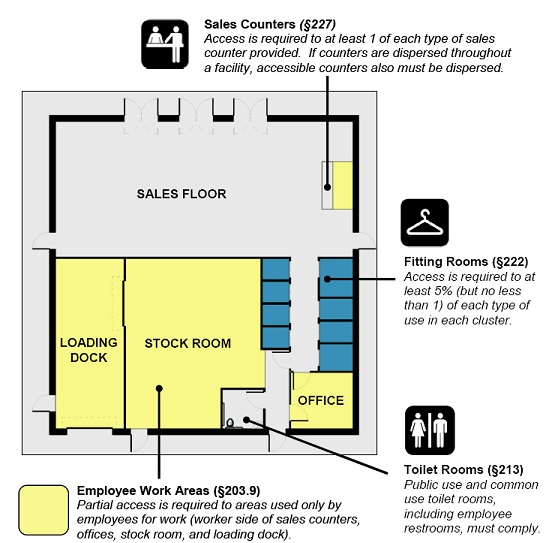

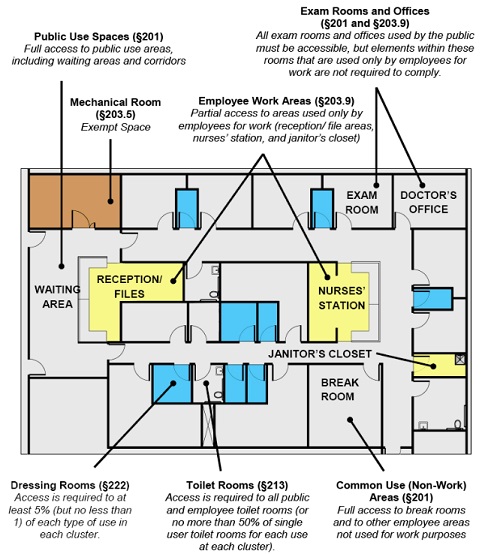










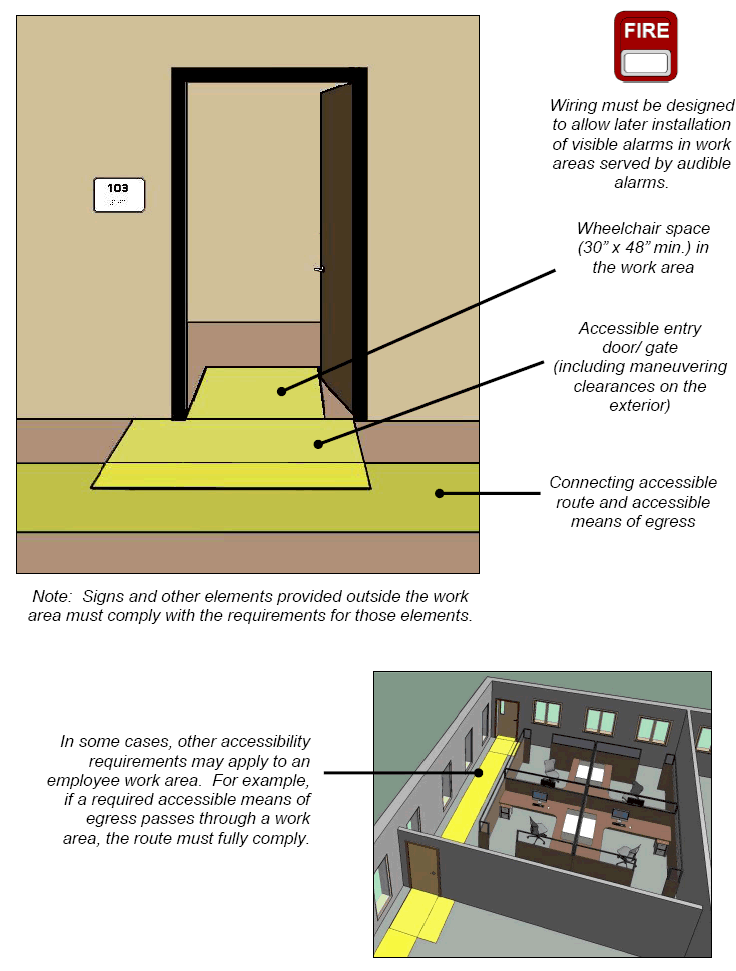
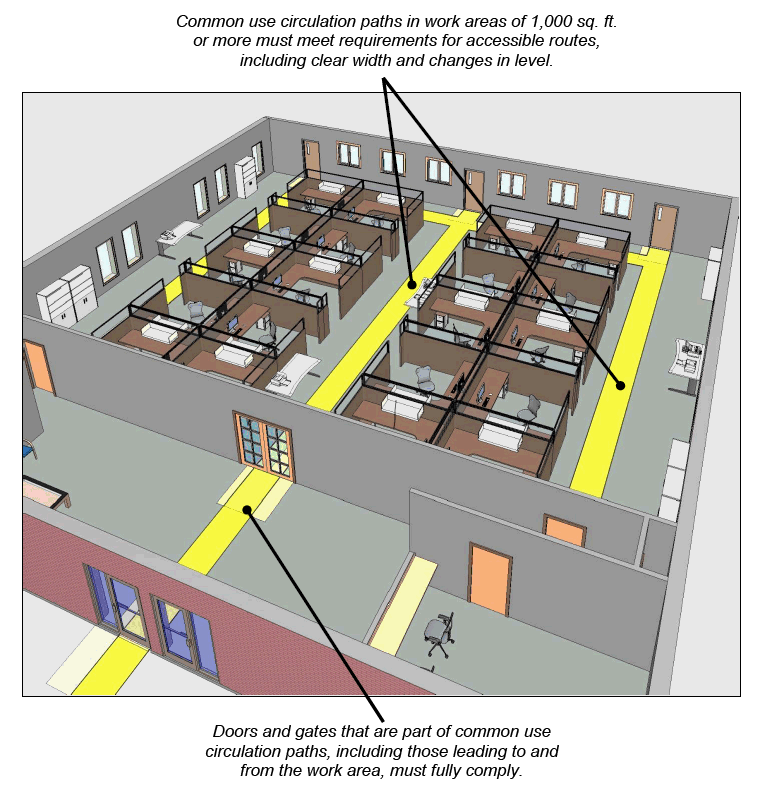
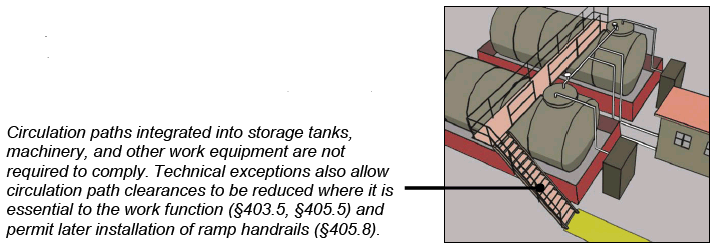



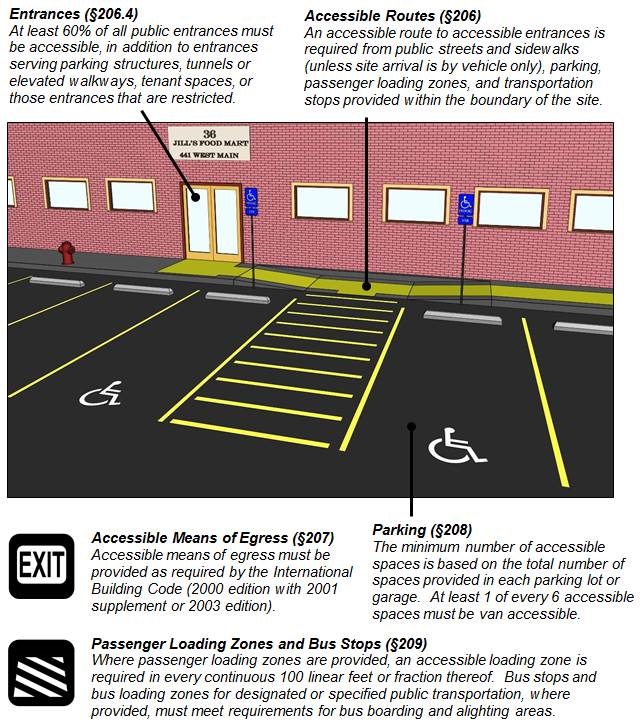
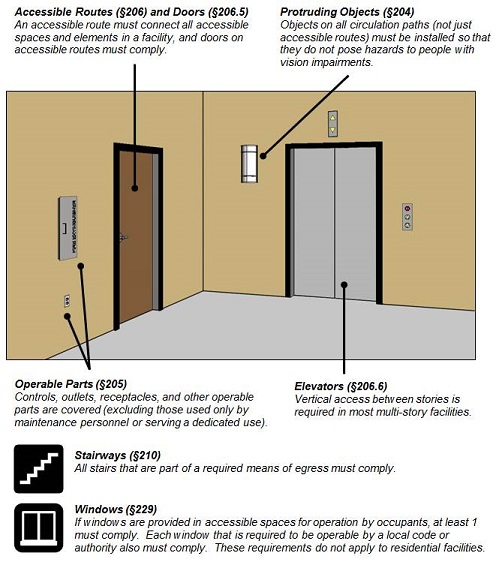
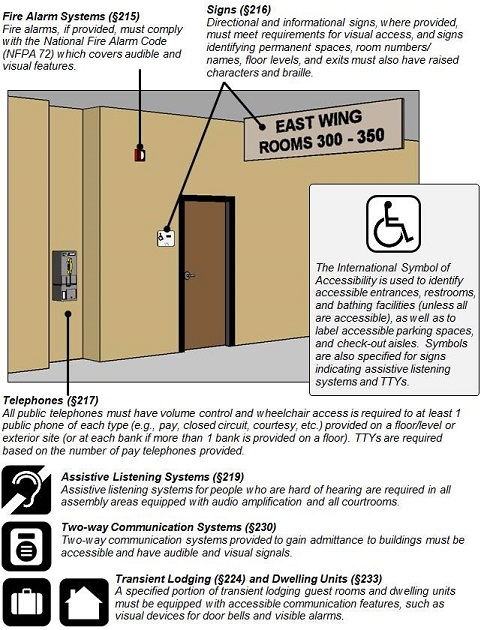
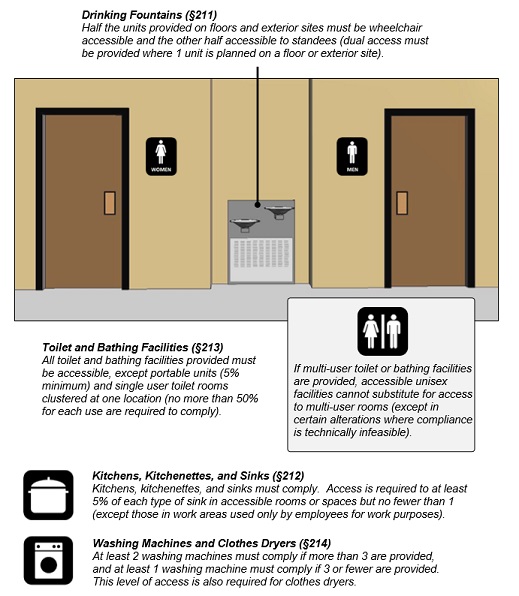
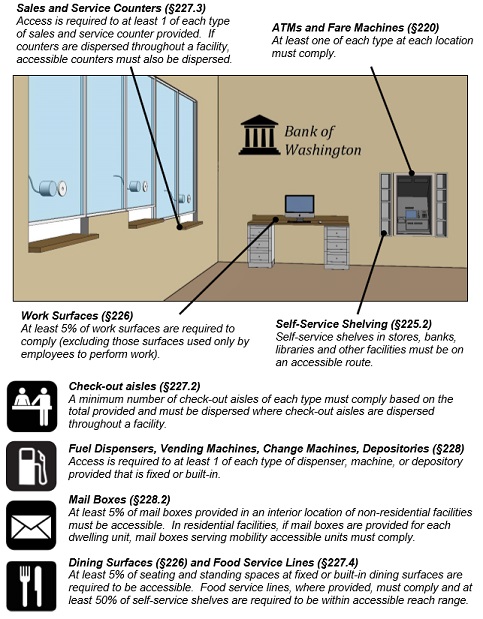











User Comments/Questions
Add Comment/Question